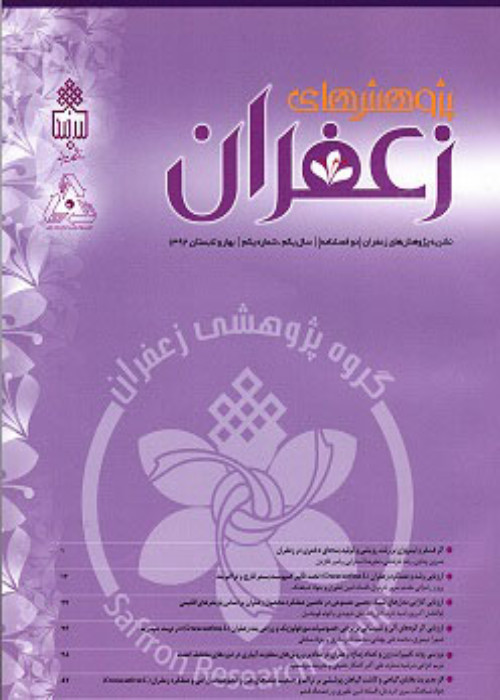Effects of Foliar Application of Iron and Zinc Micronutrient Elements on Quantitative and Qualitative Yield of Saffron (Crocus sativus L.)
Saffron (Crocus sativus L.) is an herbaceous and perennial plant, which is at least 3500 years old and is known as a golden seasoning and red gold due to its many medicinal uses. About 90% of the world's saffron is grown in Iran. India, Afghanistan, Greece are in the next ranks. Despite the high value of this plant, a decrease in its yield has been reported in many countries. The average yield of saffron per unit area in Iran is far lower than many countries; therefore, with proper nutrition, the yield per unit area can be increased. Micronutrients have a special role in agricultural products despite their low need. Iron and zinc are considered important elements in plant nutrition, and they are available in abundance in the soil, but due to some reasons, their absorption is very low and limited. Nutrition management in saffron cultivation is one of the important issues in the production of this valuable product. Therefore, the present research was conducted with the aim of studying the effect of foliar application of iron and zinc on the quantitative and qualitative traits of saffron in the research farm of the Faculty of Agriculture, Lorestan University, Khorramabad, Iran.
The experiment was carried out in the research farm of the Faculty of Agriculture, Lorestan University at Khorramabad, Iran in the crop year of 2021-2022 on 6-year old saffron plant as a complete randomized block design in three replications. In order to analyze the soil and determine the concentration of elements, a composite sample of the farm soil (0-30 cm depth) was prepared and the physicochemical properties of the soil were tested. The experimental treatments included distilled water as control, 5% iron foliar, 5% zinc foliar, 5% iron + 5% zinc foliar. Spraying of iron and zinc solutions were done in two stages (mid-March and mid-April) at 8-10 am. One irrigation was done in early October. Weed control was done by manual weeding in several stages. The flower picking operations were carried out in the middle of November 2022 and the characteristics of fresh weight of flowers, number of flowers per unit area, fresh weight of stigma, dry weight of stigma, percent of safranal, picrocrocin and crocin of stigma were measured. The flower was harvested at the beginning of the day. Then the petals were separated from the stigma.
The results indicated that the effect of foliar treatment was significant so the number of flowers (by 57.81%), fresh and dry weight of flowers (by 20.62% and 80.97%), fresh and dry weights of stigma (by 44.22% and 65.27%), crocin (by 6.88%), picrocrocin (by 11.39%)and safranal (by 9.66%) were increased because of zinc foliar application. The low effect of combined treatment of iron + zinc compared to the control can be related to the interaction of iron and zinc on the saffron plant, or that mixing these two types of elements may have negative effects considering the other ingredients included in their formulation on the absorption of the two mentioned elements or metabolic processes of plants. The availability of elements needed by the plant increases the number of flowers. Foliar spraying with zinc element showed a higher average compared to iron foliar spraying and zinc + iron foliar spraying. Crocin had a positive and significant correlation with traits such as picrocrocin and stigma dry weight, but safranal did not show a significant correlation with any of the studied traits.
Foliar application of micronutrient elements improved the quantitative and qualitative yield of saffron plant. The results of current experiment showed that foliar application of 5% iron and 5% zinc increased the quantitative and qualitative traits of saffron plants. Foliar spraying with zinc element showed a higher average compared to iron foliar spraying and zinc + iron foliar spraying. Considering the lack of zinc element and the low absorption of iron element in Iranian soils, it is recommended to apply micronutrient element foliar application in order to achieve high performance.
- حق عضویت دریافتی صرف حمایت از نشریات عضو و نگهداری، تکمیل و توسعه مگیران میشود.
- پرداخت حق اشتراک و دانلود مقالات اجازه بازنشر آن در سایر رسانههای چاپی و دیجیتال را به کاربر نمیدهد.



